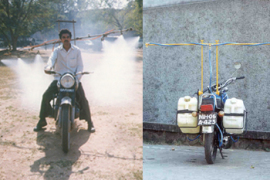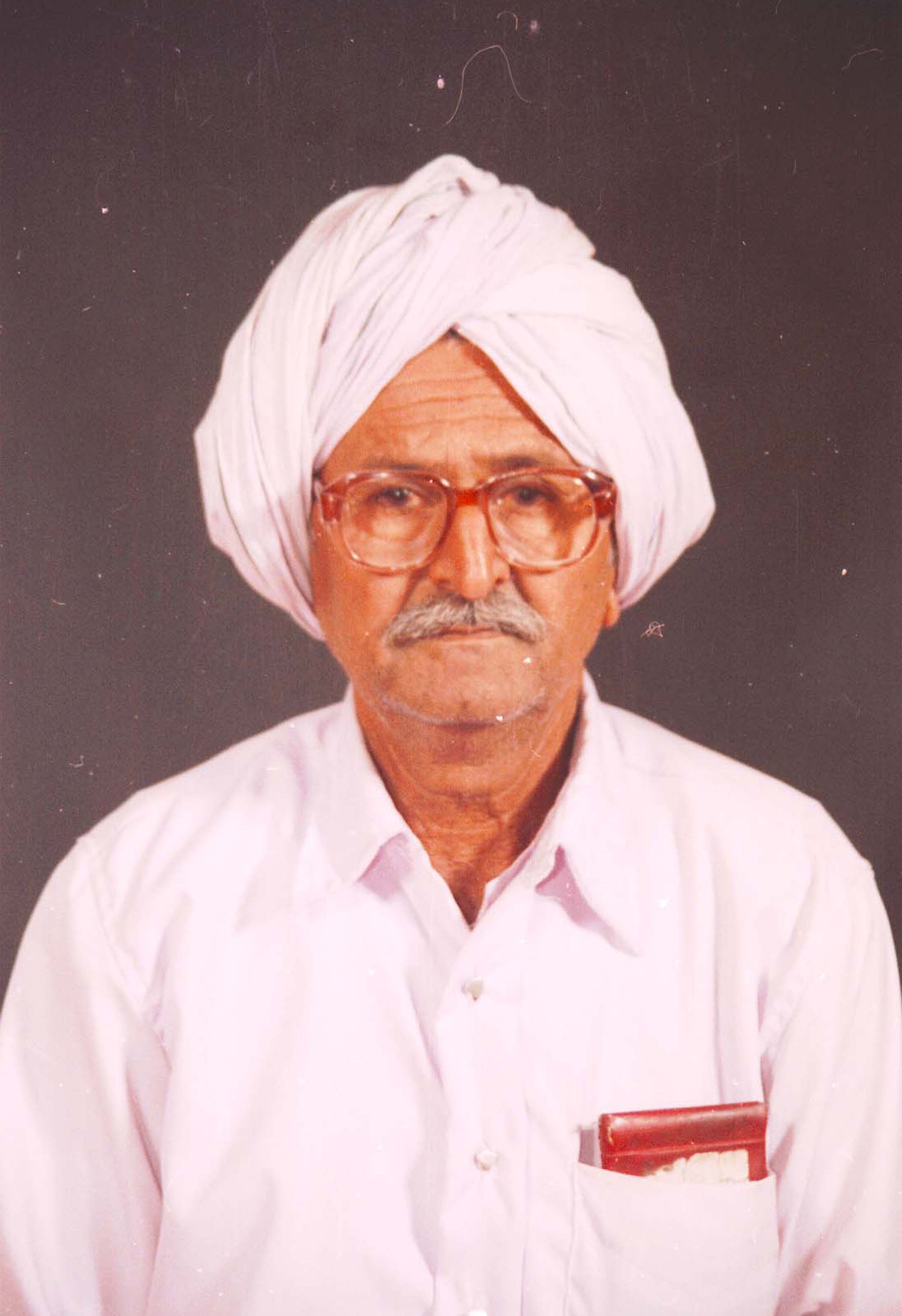Motorcycle sprayer
Ganeshbhai Nanjibhai Dodiya (54) hails from Ghogha Samdi Village of Bhavnagar district, Gujarat. He has been tending farms ever since he was 12 and circumstances forced him to be familiar with agricultural machines and implements from a young age, since finding labour has always been a problem in that region.
He currently has 4.8 hectares of irrigated land which he inherited from his father. He also owns a tractor and a sizeable cattle-shed housing buffaloes, cows and goats. He cultivates cotton, bajri (pearl millet), jowar (sorghum) and tuver (pigeon pea - Cajanus cajan).Ganeshbhai did not go to school but later in life went to “ Praudh Sikshan Kendra”– an Adult Education Programme of the Government for a few days and therefore now he is able to read and write to a certain extent. He has a daughter and three sons. Two of his sons are involved in farming and one is working in a diamond processing unit. The average annual income of the family is around one lakh rupees.
Genesis
Ganeshbhai decided he had to somehow overcome the perennial labour shortage by developing some machine for pesticide spraying that would drastically reduce labour requirement. He was fairly well acquainted with several agricultural machines and was quite comfortable operating and repairing them. He was also a keen observer. He once came across cement mortar being cured by spraying water on floorings, plasters etc. The task was accomplished by using a pump that was driven by a small motor or portable engine. He believed that a pump could be adapted to work as a sprayer as well. So, he coupled a pump to the prime mover he already owned -- his own motorbike, a standard Enfield and it worked!
This innovative sprayer is mounted on an Enfield motorcycle and is powered by its 5 HP engine. The spraying of pesticides is done through a nozzle mounted on a spray boom installed at the back of the motorcycle. The pesticide filled tank is placed above the pump and gravity ensures that the pump is automatically primed, as the fluid tends to flow into the pump and flood the chamber. It has five openings-two are connected to the regulating valves to control the spray, one to the pump, one is the air inlet and one is connected back to the tank to return the excess fluid. Air enters the system from the inlet once the water is pumped. The regulator valves serve the purpose of balancing air pressure and controlling the outlet pressure. Water is pumped in the system and the returning water serves the function of stirring the mixture in the tank. As the motorcycle is driven between rows of plantation, the pump sprays pesticides on the crop.
The innovation can be attached to any Enfield Bullet motorcycle. The sprayer is used eight times a month during the three-month long cotton-growing season and one acre of land (0.4 ha) requires roughly 300 litres of the mixture for spraying. This unit consumes three litres of diesel in three hours and can finish 1.5 acres at one go within an hour. The capacity of the tank is 70 litres.
The furrows of a cotton field are normally six feet (1.9 M) apart and one can easily ride a motorcycle through the field. The height of the sprayer is adjustable to suit the height of the cotton plant at the time. But when the crop is full-grown, it is difficult for a motorcycle to move in between the rows. For spraying at this stage, he made an arrangement in which the vehicle and the pump coupled to it are parked outside the field and a 100-feet-long (30 m) flexible pipe is used to spray the field.
Advantage
This is an extremely flexible product with adjustable height and width of spraying boom. Since a motorcycle requires less space to move it can be used in a more versatile manner as compared to power sprayers that are mounted on tractors. It is much simpler to assemble and dismantle and takes hardly10 minutes to assemble on to the motorcycle. Since the pesticide is sprayed at very high pressure, the spray is extremely fine and wastage of pesticide/insecticide is minimized. Since crops like cotton demand frequent spraying, this Enfield sprayer comes as a boon in times of labour scarcity. The spraying time is greatly reduced as the motorcycle mounted sprayer can cover more area in two hours than manual labour can cover in two days. This is also a highly energy-efficient product. The initial cost as well as operating costs of the sprayer is quite low compared to other power sprayers. It is also easier to handle and lighter than the conventional back operated knapsack sprayers. With this sprayer no extra labour is required as the farmer himself can cover the field.
Of great relevance
The most critical operation in cotton-farming is to protect the crop from bollworm and other similar pests. Repeated application of pesticide is the bane of cotton cultivation, although it is a lucrative cash crop. The comparatively small size of the cotton fields found in most regions of India virtually rule out aerial spraying for crop protection. More than 90% of spraying is done by manual sprayers like knapsack sprayers and foot pump sprayers. But these conventional sprayers are slow and require tedious manual cranking to operate. Another problem is the acute labour scarcity due to the movement of labourers toward cities for diamond cutting/polishing which pays quite high wages. Small farmers with limited land holdings cannot afford to buy the tractor-mounted sprayers or power sprayers available in the market, as these are very costly. Thus due to the inability to spray the fields quickly and effectively, the small farmers have their crops wiped out by pests. This motorcycle operated sprayer of Ganeshbhai’s offers a solution to most of these problems.
Technology diffusion
Ganeshbhai has made a prototype for his own use. About 40 cotton farmers in adjoining districts have adopted the technique especially as most land-owning households in the Saurashtra region have motor cycles, which is a multipurpose and durable vehicle for them. A few farmers have also made their own machines incorporating some modifications and gone ahead. Mansukhbhai Jagani, another innovator who lives in Amreli district, was asked to evaluate whether this innovation could be so modified that it could be attached to any motorbike instead of just one model. Mansukhbhai accordingly made some alterations so that this unit can be fit on any motorbike. This innovation was one of those from India displayed in South Africa on June 12-14, 2002 in an exhibition organized by the Department of Small, Medium & Micro enterprises (SMME) of Northern Provinces, South Africa jointly with the Commonwealth Science Council (CSC), London.
Adding Value..
How sometimes an innovator can feel betrayed in the process of value addition is brought out in the case of Ganeshbhai Dodiya. Students from IIT-Bombay took up a project to add value to his motor cycle driven sprayer. At the time of the Science Congress held at Pune in January, 2000, he was invited to showcase his innovations. When the improved sprayer was brought for display from IIT, Ganeshbhai got upset. He would not call this so called improved sprayer as ‘his’ innovation. When media approached him to pose for a photograph, he would not agree. When the reason for his displeasure was probed, he pointed out that in the so called improved sprayer; the power was drawn from the wheel. Thus when the motorbike would be standing still, the sprayer would not work. Whereas in his design, the motive force was drawn from the engine. The motorcycle might be still but the engine could work and power the sprayer. Everyone involved learnt a lesson from this incident- all realised that it was very important to draw upon the innovator’s own vision while trying out improvements.
His project was supported by Department of Scientific and Industrial Research, GOI, under Technopreneurial Promotion Programme (TePP) through GIAN (West) in the year 1998-1999. The modified bike now improved by Mansukhbhai has removed the limitations of the new design. It is also interesting to note that after a while Ganeshbhai lost interest in his innovation. He asked GIAN to take up the further value addition and business development through any other innovator or entrepreneur since he wanted to focus on his farming.








